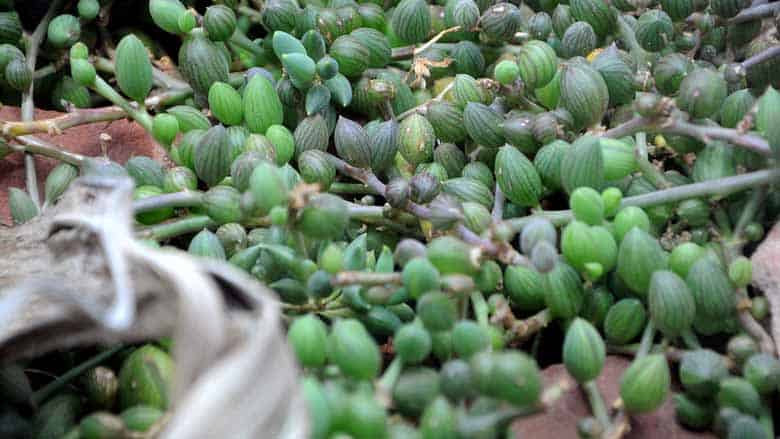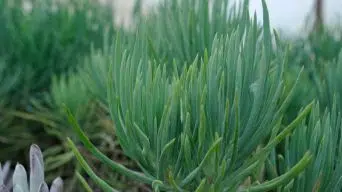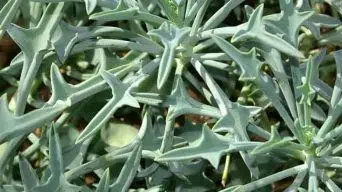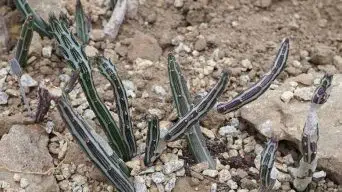String of Tears (Senecio herreianus or Curio herreianus) is a succulent plant with long, narrow green leaves with a stringy appearance.
They are usually grown for their stringy white flowers. Still, they also make excellent houseplants because they can survive in a wide range of conditions.
Senecio herreianus care is not as hard as one might think.
This guide will give you all the information you need to make String of Tears care easy for yourself and ensure your Senecio herreianus grows healthy and strong!
Overview
Senecio herreianus, commonly known as the String of Tears and, more recently, Curio herreianus, is a perennial succulent.
It is a member of the Asteraceae family that belongs to the genus Senecio and comes from South Africa.
The String of Tears has its name for its creeping stems and tear-shaped foliage. They grow in clumps with long, trailing stems covered by white or silver hairs.
The Senecio herreianus plant is a flowering low growing trailing succulent.
String of tears plants typically have stems that grow to about one foot in length and produce white trumpet-shaped flowers.
Other common names for this succulent include:
- String of Beads
- String of Teardrops
Senecio herreianus is a close relative of two other string plants: Senecio rowleyanus (String of Pearls) and Senecio radicans (String of Bananas).
How To Care for String of Tears (Senecio Herreianus)
String of Tears care is a fairly simple process.
Below are a few things you need to know about String of Tears (Senecio Herreianus) care.
Sun Exposure & Light Requirements
String of Tears plants will grow best when they are grown in partial shade or indirect bright light.
Senecio herreianus plants will grow best in areas where they are not experiencing strong direct sunlight, so they should be grown under a tree or bush when grown outdoors.
String of Tears plants can also grow well indoors as long as there is some indirect light.
They can be placed in an east or south-facing window and should receive at least six hours of indirect light each day.
Watering Requirements
The String of Tears plants need to be watered once a week or every two weeks.
This Senecio plant should only be watered when the soil is dry.
The best way to check if String of Tears needs to be watered is by feeling the soil.
If it feels moist, then String of Teardrops don’t need water yet, but if it doesn’t feel moist and you can easily poke a finger into the dirt about an inch, it needs watering.
String of Teardrops doesn’t tolerate being overwatered, meaning you should never leave water sitting in their pot for extended periods.
Soil Requirements
String of Tears care starts with the correct type of soil.
They prefers a very well-draining, sandy, or loamy soil rich in organic material.
String of Tears does not like soils with high levels of clay. String of tears plants should not be grown in very heavy, poorly drained soils as they are prone to root rot.
A cactus/succulent soil mix is perfect for String of Tears plants.
Temperature and Humidity
String of Tears plants need a temperature range between 18 and 24 degrees Celsius (64.°F – 75.°F).
These plants are very susceptible to frost, so String of Tears should be protected from cold temperatures.
The String of Tears plants have average humidity requirements, which should be kept at around 50%.
Fertilizing
String of Tears plants should be fertilized once a year, preferably during the summer months.
Apply a weak solution of balanced, water-soluble fertilizer diluted to half strength.
Avoid over-fertilizing String of Tears plants, as they can become too soft and lose their shape.
String of Tears plants are not heavy feeders and will thrive on a much less frequent feeding schedule.
Potting and Repotting
String of Tears plants are usually used as ground covers.
They can be grown in containers but grow best when planted into the soil with good drainage.
String of Tears plants need to be planted in a pot that is deep enough for the plant’s roots and not too narrow.
They are susceptible to root rot, so using drainage holes or gravel at the bottom of your container is important.
Senecio herreianus do well when grown with other low-water tolerant species like succulents, sedums, and sempervivum if they’re only watered minimally during hot months.
String of Tears plants require repotting every two to three years. You’ll know String of Tears is ready for a new pot when the roots start to come through the bottom of the current one.
Senecio herreianus plants should be transplanted during the fall or winter months.
The String of Tears can also grow as a hanging plant. They thrive in hanging baskets if they are given support to cling onto, like string or wire.
Pruning
String of Teardrops care requires trimming every now and then for more air circulation around the String of Tear’s foliage, which reduces humidity buildup around the String plant’s center leaf layer.
They should be trimmed back to the point where new String leaves start growing.
String plants can suffer from over-trimming, but under-trimming will cause a String plant to grow too tall for its pot and topple over in just a few months.
Make sure not to cut off healthy String leaves when pruning String of Tears.
Trimming String plants will increase the amount of String plant flowers next season because fewer String leaf sheaths are available to support flower buds, which is when they form.
The best time to trim String of Tears is September through October before new growth starts coming out for the year after their dormant period has ended (generally in December).
Pests and Diseases
Although String of Tears plants are usually pest-free when properly cared for. The following pests can attack String of Teardrops:
- Whitefly
- Spider Mite
- Mealybug
- Aphids
- Scale Insects
String of Tears plants can also develop the following diseases:
- Fungal Disease
- Verticillium Wilt
- Botrytis Blight.
String of Teardrops are susceptible to several types of fungal infections, including powdery mildew and rust.
These pathogens typically invade Senecio herreianus when the succulent experiences stress or lacks adequate care.
String of Tears plants grown under these conditions and not treated with fungicides can be affected by rust for the duration of their lives.
Senecio herreianus may also develop a fungus called Botrytis Blight, which is considered a very serious disease.
The best way to avoid String of Tears plant diseases is by providing String of Teardrops with ample light, good air circulation, and high humidity.
String of Tears plants that are grown under these conditions will be more resistant to disease development than those String of Tears plants not cared for properly.
How to Care for String of Tears (Senecio Herreianus) in Winter
String of Tears (Senecio herreianus) winter care is not very complicated. Still, it is important to note that String of Tears plants are frost-sensitive and need protection from the cold.
Senecio herreianus care starts with the right planting conditions since these plants do not tolerate cold temperatures, frost, or snow.
Theyare small succulents that can be grown indoors or outdoors as long as they have good sun exposure and well-drained soil.
String of Tears care is easy in winter when String of Tears (Senecio herreianus) is dormant; this means String of Tears does not need much water, but it will appreciate supplemental watering during prolonged droughts.
String for Teardrops care continues by checking on your plant daily to see if it needs water and to watch for pests.
How To Propagate Senecio Herreianus (String of Tears)
String of Tears is a succulent plant that can be propagated through stem cuttings or leaf cuttings.
Stem Cutting
String of Tears can be propagated through stem cutting.
Take a Senecio herreianus plant that has just flowered and let it dry for about two weeks to kill the sap. Then, cut off about a six-inch (15cm) piece below where the flowers were located on the stem before they bloomed.
Put this in the soil so it sticks out from beneath the surface but not too high above ground level. Cover with soil or an organic mulch like peat moss, straw, or hay until completely buried.
This will promote rooting at its base as long as no weed seeds are in your propagation area shortly after planting.
String of Tears plants grow best when planted outdoors during springtime using their natural environment into consideration.
If you live in a colder region, String of Tears plants should be planted in the fall or winter months so they can get enough time to establish their roots before it starts getting cold and drying out again.
Leaf Cuttings
String of Tears can also be propagated through leaf cuttings.
Take String of Tears leaves that have been thoroughly dried and cut off a healthy one-inch (25mm) section.
Put it in a pot of soil with the cut end facing upwards and cover it with a bit of soil. Keep the soil moist to promote rooting.
Do not place String of Tears in direct sunlight, or they will dry out. Place String of Tears where it can be watered easily and receives indirect light.
The Senecio herreianus leaf will soon sprout roots, and String of Tears will be ready to be transplanted.
Is the String of Tears (Senecio Herreianus) Toxic?
String of Tears (Senecio herreianus or Curio herreianus) is mildly toxic to people and most pets.
String of Tears should not be consumed, and it should be kept away from children. It can be toxic to dogs, cats, rabbits, and horses, so keep it out of their reach too.
It’s always recommended to wear gloves when handling String of Tears.
Final Thoughts
The String of Tears (Senecio herreianus) is a very easy to grow plant.
Growing String of Tears can be a wonderful experience as Senecio herreianus provides a soothing ambiance to our home.
It also has the potential to become very invasive. Make sure that Senecio herreianus is not planted near roads or other properties, which can become at risk from String of Tears invasion.
Lastly, String of Tears care needs to include periodic weeding because it grows fast and will take over all your plants if you let them grow unchecked!







